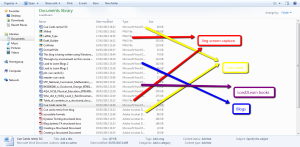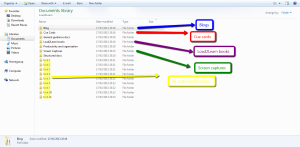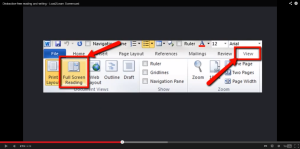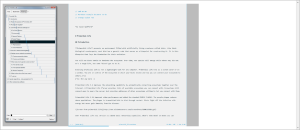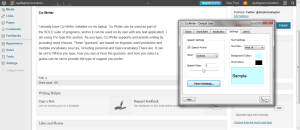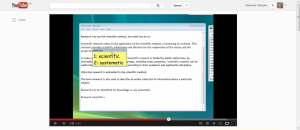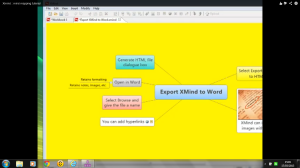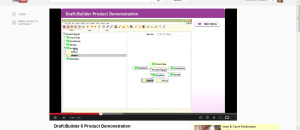Voice
As part of the Inclusive Technologies for Reading course I have explored various ways that “voice” can be used to help students with print disabilities. Text-to-speech (TTS) and audio can support dyslexic and visually impaired students. E.A Draffen says TTS voices “can place a greater demand on cognitive resources to facilitate understanding in comparison to natural voices”. They can be much harder to listen to more tiring and some find, more boring. However “high quality TTS and natural voice were more intelligible than the low quality TTS voices and high quality TTS voices resulted in higher comprehension scores”.
TTS which uses a bi-modal reading system where the text is highlighted as the words are spoken can be especially useful for dyslexic learners. It is useful to be able to control the speed of the voice. Normal readers can cope with 300 wpm and those that have been blind from birth can read at speeds of 400wpm listening to the more robotic voices. However dyslexics need higher quality voices at slower speeds of 150-180 wpm or even less.
Students will have personal preferences for a the voice. If possible, try out a range of voices with the student to see what works best for them. Try the more robotic voices, high quality voices, different gender, different age (children’s voices are available) and different countries and accents (e.g.Welsh, Scottish, Indian etc). Remember you can change the rate and pitch of the voices. Not all software will accept all voices.You may find that students prefer different voices for different reading tasks such as reading a quick note as opposed to a lengthier text or reading for information as opposed to reading purely for enjoyment.
WordTalk and Balabolka
WordTalk is an add-in to Word that will read Word documents easily with the built in Microsoft Anna voice. It also easily used the higher quality Amy and Brian voices I tried from Ivona. I did have problems downloading the free trial but Ivona were very helpful. The student can follow the text as it is highlighted and can save to an MP3 or WAV format to listen to later on an MP3 player.
Balabolka can read Word and PDF documents and use any SAPI voice on your computer and it too can create MP3 files.I tried this out with the various voices both inbuilt and commercial. Once voices are installed on your computer, Balabolka finds them and you can select and try out the different ones in a dropdown menu which is located through View – Show – Configure Voice.
Personally, I prefer to listen to the higher quality voices and will purchase probably two of the voices, one male and one female, to demonstrate to schools when the trial period finishes..
Ivona Mini Reader
I have also tried out Ivona Mini Reader on a free trial with the Ivona voices and Microsoft Anna. It reads out any text that you highlight. I have found this very useful. It sits in an unobtrusive floating toolbar which lets you adjust speed, volume and select voices easily and quickly. It is ideal for helping students unobtrusively with a difficult sentence or word.
AMIS
I intend to try out AMIS to read DAISY books when I have time over the Easter holidays as I have had problems downloading this. For further information on how AMIS works I recommend that you look at “My experience with using the Daisy reader software EasyReader and Amis” by ictXplore
ClaroCom
ClaroCom is a new app designed primarily for Augmentative and Alternative Communication (AAC). An AAC app helps to replace speech or assist writing for those with difficulties in the production or comprehension of spoken or written language. The free app comes with two voices, Daniel and Serena, which are high quality TTS voices. Both can be adjusted for speaking rate from 90wpm to 240wpm. It comes with built in phrases but there is a window which you can type into and then tap the speech button to hear the words spoken. I think that this has possibilies for an easy support for writing for dyslexic students. It has the facility to email, copy and send messages. The Pro version has nine voices and feeds directly into Facebook and Twitter. I can see how older dyslexic students may really like being able to feed into social media easily.
Audiobooks
Another way of accessing print is to listen to an audio book which has been narrated. Audiobooks (www.audiobooks.org) has free audiobooks, all MP3 format and iPod compatible. They have public domain books narrated by volunteers through Librivox (www.librivox.org). I listened to “Treasure Island” which was free and a Librivox production.This was an enjoyable listening experience. Expession and pronunciation was good and easier to listen to for a whole story than a TTS or robotic voice. Many dyslexic students never read for pleasure. Consequently their vocabulary suffers. One way to enable vocabulary development and also give them the pleasure of a good story, is to introduce them to listening to books. This is becoming increasily more accessible due to MP3 technology and apps. Recent research by Learning Ally (www.LearningAlly.org) a not-for-profit volunteer organisation in America, pointed to better scores in maths and reading test scores for readers with disabilities who use audiobooks.
I have used “Listening Books” (www.listening-books.org.uk) with primary students previously and they have really enjoyed this way of accessing stories. Membership costs £20 per year and members can have MP3 CDs sent through the post,download to a portable player or can listen to over a thousand audiobooks live through streaming.
Blio
Blio (www.blio.com) is a full-featured free e-reader which lets you see books as the author intended. It comes with TTS integration, with support for both a computerised voice and synchronisation with professionally recorded audiobooks. I bought the Heather voice for £6.99 which I think sounded better in the sample than it did once purchased and reading a book. You can adjust the speed and volume of the voice but you cannot change the type face or size of type although you can change the page colour and the brightness. It does have bi-modal reading. I didn’t like the type and I found it awkward to change the settings while reading. It is difficult to find free books in the store.

